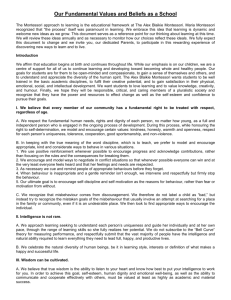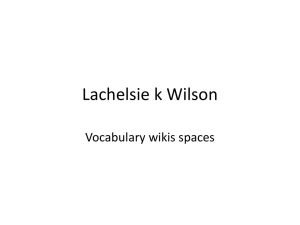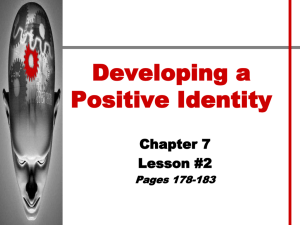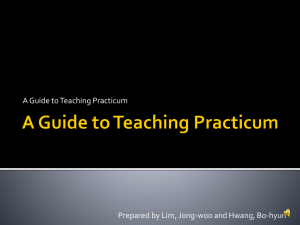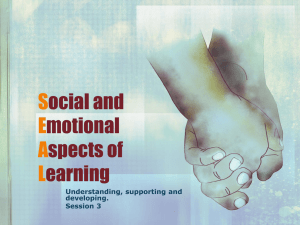Comparing Children's Self-Esteem Levels in Montessori versus Traditional Schools
advertisement
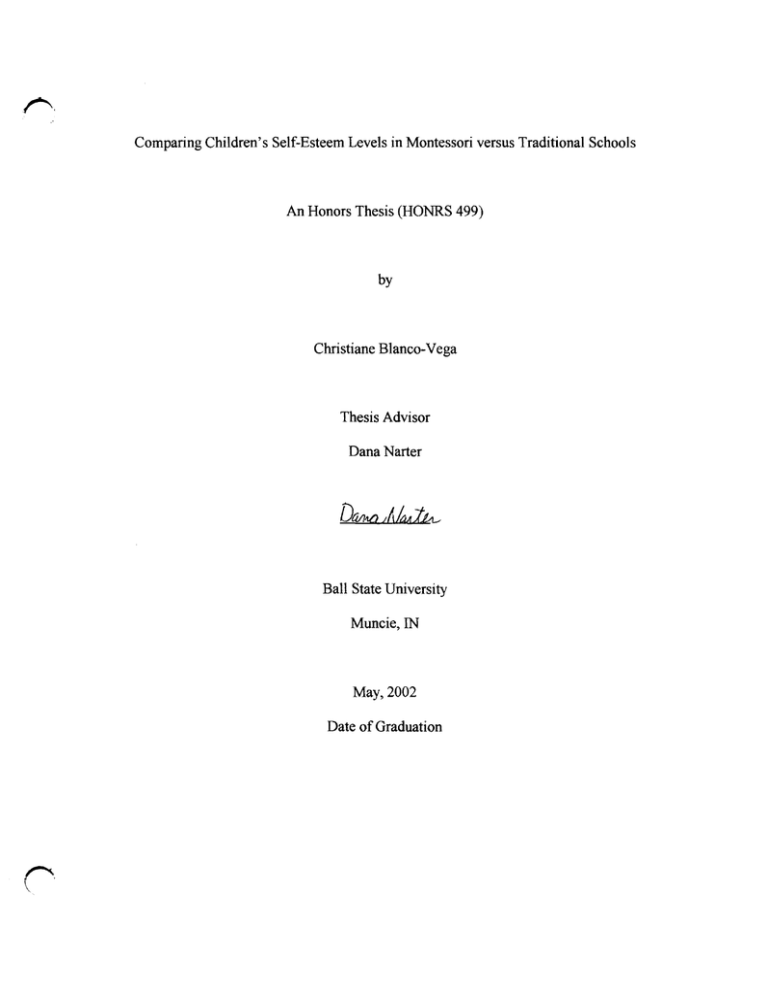
Comparing Children's Self-Esteem Levels in Montessori versus Traditional Schools An Honors Thesis (HONRS 499) by Christiane Blanco-Vega Thesis Advisor Dana Narter Ball State University Muncie, IN May, 2002 Date of Graduation ~> \ .,/)., Abstract .. .; This study has two main purposes. The first purpose is to investigate the impact of the Montessori method on one component of socio-emotive growth: self-esteem. Another purpose is to better educate parents, teachers, and potential readers of this thesis, about the impact of a different method of education, in this case Montessori. Participants were 10- to -12-year-old children attending either traditional (n=16) or Montessori (n=20) schools. The Culture-Free Self-Esteem Inventory Form B (Battle, 1992) was completed by the children in order to measure levels of self-esteem. The results support the hypothesis that children who attend Montessori schools have higher levels of self-esteem than children who attend traditional schools. Limitations to this study as well as a call for more research will also be discussed. Acknowledgements I would like to express my most sincere gratitude to my faculty mentor, Dr. Dana Narter, for her role in the accomplishment of this project. Her guidance and constant feedback provided me with the necessary tools needed to finish this challenging endeavor. Thank you, Dr. Narter, for your support and time investment. I would also like to thank my fiance Heath for his patience and understanding that supported me during those frustrating times when things did not seem to work the way they were supposed to. Thank you Heath, you helped more than you realize. Thanks to my family, who even from far away were able to show me their support. Also, I would like to thank Ball State University's Office of Academic Research and Sponsored Programs for their support in the form of an Undergraduate Internal Grant. Thank you for supporting and sponsoring undergraduate research like mine. Last but not least, I would like to thank the four schools that participated in this project, and to all the children without whom this project would have never been possible. Self-Esteem Levels in Children Running Head: SELF-ESTEEM LEVELS IN CHILDREN Comparing Children's Self-Esteem Levels in Montessori versus Traditional Schools Christiane Blanco-Vega Ball State University 1 Self-Esteem Levels in Children 2 Abstract This study has two main purposes. The first purpose is to investigate the impact of the Montessori method on one component of socio-emotive growth: self-esteem. Another purpose is - to better educate parents, teachers, and potential readers of this thesis, about the impact of a different method of education, in this case Montessori. Participants were 10- to -12-year-old children attending either traditional (n=16) or Montessori (n=20) schools. The Culture-Free SelfEsteem Inventory Form B (Battle, 1992) was completed by the children in order to measure levels of self-esteem. The results support the hypothesis that children who attend Montessori schools have higher levels of self-esteem than children who attend traditional schools. Limitations to this study as well as a call for more research will also be discussed. Self-Esteem Levels in Children 3 Comparing Children's Self -Esteem Levels in Montessori versus Traditional Schools Today more than ever, Americans are evaluating the functions of schools not only academically, but also socially and psychologically. Recent school violence outbursts throughout the nation have left the people in this country asking themselves exactly what could be the problem(s) leading these children to commit such acts. It is very important that attention be drawn towards aspects of children's needs that the school system may be ignoring, but that might be important in order for children to have a more meaningful and successful experience in school. One of these aspects might be self-esteem. Self-esteem has been defined to be one's level of self-acceptance (Coopersmith, 1967). Although the term itself has been used for many years, clinicians and researchers have not devoted serious attention to this concept and its effects on other facets of life. However, during the past two decades, Battle (1992) has drawn some attention to this issue and has conducted extensive research on the relationships between self-esteem and several different human factors. From his findings, he reports that self-esteem is associated with depression among children and adults, learning disabilities in children, and anxiety among children, adolescents, and adults. Self-esteem has also been associated with academic achievement, with ADHD, and even with employment. These findings show how important it is to give more attention to the issue of selfesteem levels, since self-esteem can have such an impact in so many instances in life. It seems that the educational community has paid little attention to the role that self- esteem may play in students' achievement and general sense of satisfaction. Battle (1992) notes that during the fifties and sixties some attention was drawn towards the concept of self-esteem, but ever since, few researchers (Battle, 1982, 1987, 1990; Coopersmith, 1967) have focused their interests in the importance of self-esteem in the field of education. However, self-esteem is a Self-Esteem Levels in Children 4 concept that may already be embraced by alternative methods of education from which important lessons may be learned. One of these alternative methods is the Montessori approach. One term important to define in order to better understand the present study is the "Montessori method". Dr. Maria Montessori was an Italian physician who started the Montessori method of education early this century. During the first years, Dr. Montessori was working with mentally challenged children in Rome, trying to help these children to tit into society. After some years, she started to use her methods on normal children, and she found that they had very good effects in the children and their learning experiences. It was then that Dr. Montessori, based on her scientific observations, decided to create a method of education in which children could tind specific materials to manipulate according to their own interests, their own ages, and where they could also learn from older and younger students in the same environment. In order to attain this goal, she divided children into groups based on age (0-3 years, 3-6 years, 6-9 years, 9-12 years, and 12-14 years). Dr. Montessori concluded that by grouping children in this manner, and by making accessible to them special materials specitically designed to develop certain skills that were age-appropriate and that the children would naturally seek to learn, children would be provided with the right environment to learn and to develop fully. The only guidance these children receive, besides that from other classmates, is from a specially trained teacher who guides students to tind self-discipline, motivation, and love of learning (Lillard, 1996). Another term important to define is "traditional school". For the purposes of this study, the author of the present study defines traditional school as any school where the teacher is the center of the classroom and is the primary enforcer of discipline. In this school, children are Self-Esteem Levels in Children 5 grouped by age and follow a structured curriculum. These schools may be public, private, or parochial, and are generally the majority of the schools found in American communities. Self-esteem is an important factor for the child, not only for their academic success, but also for their development as a healthy social being. For instance, Schreirer and Kraut (1979) have noted that psychologists as early as William James and George Herbert Mead have discussed that a person's beliefs about themselves will influence their decisions and actions throughout life, and that a high self-esteem will lead a person to constructive social behavior; whereas low self-esteem will lead to inadequate social behaviors. These authors stated that having positive feelings about themselves will help children in school achievement. Parents and educators seem to have very little information concerning non-traditional educational methods, and their influence on self-esteem. If this study is able to demonstrate that the Montessori method might have a positive effect on children's self-esteem, then the findings will be an incentive for more research on this and other alternative methods of education. It is also my belief that some day, professionals will be able to incorporate research findings ofthis nature into a more stable and whole education system. Thus far, very little research has been conducted that address the impact of educational methods on children's levels of self-esteem. Some of this research focuses on open classrooms (schools that emphasize self-direction and self-stimulation, team teaching, and have no classroom division as traditional schools do). For example, Fry and Addington (1984) conducted a study in which children from eight open and eight traditional classrooms took a series of tests to measure constructs such as cognitive development, social problem solving, and self-esteem. Participants were 200 children in elementary school, with an average age of 9 years old. The authors adopted older ego strength and self-esteem measures into an 80 TruelFalse item scale, Self-Esteem Levels in Children 6 with no indicated reliability or validity. The authors found that open classroom respondents had significantly higher scores in self-esteem than the traditional classroom respondents. A limitation to this study is that the construct "open classroom" is too general. Another limitation of this study is that the authors fail to provide the reliability and validity of the self-esteem measure they used. th Franks, Marolla and Dillon (1974) conducted a study with 7 and 8th grade students from five parochial traditional schools and two parochial open classroom schools. The authors created their own self-esteem assessment consisting of a seven-item scale with an internal consistency of .64 and limited evidence of concurrent validity. The data supported their hypothesis that selfesteem scores were significantly higher in open classrooms. Limitations to this study include the generalization of the term "open classroom", the use of a self-esteem assessment with weak validity, as well as the gathering of data only in parochial schools. The authors of this study call for more research in this area. Miller and Bizzell (1984) conducted a longitudinal study in which the main focus was to assess long-term effects of traditional and Montessori schools on children's academic achievement and self-esteem levels. In their study, low-income African American pre-school children had been randomly assigned to either traditional or Montessori schools. Seven years later, when the students where in the ninth- and tenth-grades, they were asked to take a series of tests including IQ tests, and the Self-Esteem Inventory (SEI) by Coopersmith (1967). The SEI is a 58 True/False item scale with a test-retest reliability of .70. The authors did not find a significant difference between levels of self-esteem in the two groups. Although the authors did not find a difference, this study is useful because it provides important impetus for further Self-Esteem Levels in Children 7 research like the present study. A limitation to this study is that the authors' main focus was on academic achievement, with self-esteem being a minor focus. As has been seen, some researchers (Franks, Marolla & Dillon 1974; Fry & Addington 1984; Miller & Bizzell 1984) have noted the possibility that different educational methods may have different effects on the levels of children's self-esteem. However, these past studies have been too general or have shown some limitations. Different from past studies (Franks, Marolla & Dillon 1974; Fry & Addington 1984), the present study focuses specifically on the Montessori method versus the traditional school, making the present study more applicable and practical than the studies that used the general term "open classroom". In contrast to past studies (Franks, Marolla & Dillon 1974; Fry & Addington 1984; Miller & Bizzell 1984) the present study uses a recent, valid, and reliable measure of self-esteem. In addition, this study was conducted in both, parochial and non-denominational schools, unlike past studies like Franks, MaroBa & Dillon (1974) that have been conducted only in parochial schools. Finally, for this study the only goal is to assess any differences in levels of self-esteem, unlike the study conducted by Miller & Bizzell (1984) where the main focus was to assess academic achievement. The present study will examine the differences in self-esteem levels between sixth-grade children who attend either Montessori or traditional schools. One purpose ofthis study is to investigate the impact of the Montessori method on one component of socio-emotive growth: self-esteem. Another purpose is to better educate parents, teachers, and potential readers of this thesis, about the impact of a different method of education, in this case Montessori. It is hypothesized is that children who attend Montessori schools have higher self-esteem levels than children who attend traditional schools. Self-Esteem Levels in Children 8 Method Participants In total, thirty-six children participated in this study. There were 16 sixth-grade children from traditional elementary schools, and 20 children from Montessori schools who were evaluated by their teachers to be in the sixth-grade level. The ages of the children were between 10 and 12 years old. This age group was chosen because these children are considered to have reached the ability to think abstractly and to make general assessments of their own abilities and powers (Coopersmith, 1967). In total, data was collected from four private schools in Indiana: two Montessori schools, and two traditional schools. From the two traditional schools, there were 5 participants from one, and 11 from the other. From the two Montessori schools, there were 6 participants from one and 14 from the other. The sample consisted -predominantly of Caucasian - - . children. Materials The Culture-Free Self-Esteem Inventories Second Edition (CFSEI-2) Form B (Battle, 1992) was used for this study. The CFSEI-2 is a measure of self-esteem in various contexts (general, social, academic, and parent-related). Form B, which was especially designed for children, was utilized. This form consists of 30 Yes-No items. Some of the items read as follows: "Most boys and girls are better than I am" "I am as happy as most girls and boys" "I like being a boy/ I like being a girl" "My parents dislike me because I am not good enough" Scores are calculated by adding the total number of items checked that indicate high selfesteem; each answer that indicates high self-esteem is worth one point. A template is provided Self-Esteem Levels in Children 9 for recognizing the answers that indicate high self-esteem in each of the questions. Also indicated in the template, five of the thirty questions are termed "lie scale items" and are to be subtracted from the total score. Thus, the total score for Form B is 25. In previous studies conducted by Battle (1992) in elementary schools (n=166), the mean score for general selfesteem was found to be 18.07. Battle (1992) reports his inventories to have strong test-retest reliability, ranging from .79 to .92, and an internal consistency of .71. Validity for Form B is .86, and Battle (1992) claims that after past studies he has conducted, he is confident that the CFSI-2 is a valid measure of self-esteem. Procedure At a date determined by the school, the experimenter went to the assigned classroom where the teacher introduced the researcher to the children. The researcher explained that the study they were about to participate in would be anonymous and that the answers they provide would not affect their grades in any way (see Appendix A for Experimenter's Introductory Script). The Culture-Free Self-Esteem Inventory Form B (Battle, 1992) was distributed to the children. The directions were carefully read aloud by the researcher (see Appendix A for directions to the CFSEI-2). The children had fifteen minutes to fill out the Inventory. At the end of fifteen minutes, the researcher explained to the students the purpose of the study (see Appendix B for the Experimenter's Closing Script). Results A total self-esteem score was computed for each child by summing the total score for each individual test using the scoring template provided with the CFSEI-2. Then, a t-test was performed to compare self-esteem levels for children in Montessori versus traditional schools. The t-score proved to be statistically significant (t=(34)=1.269,p= .035), which supports the Self-Esteem Levels in Children 10 hypothesis that children who attend Montessori schools have higher levels of self-esteem (M= 20.45, SD= 2.92) than children who attend traditional schools (M=18.75, SD= 5.02). The mean levels of self-esteem for the two groups are summarized in Figure 1. In order to determine if children from anyone of the four schools where data was collected were systematically different from the children at the other schools, data were submitted to a one-way analysis of variance (ANOVA). In this analysis, school (four levels) was the independent variable, and self-esteem was the dependent variable. The results indicated that there was no one school with especially higher or lower self-esteem levels (F (3,32)= .755,p= .528). See Table 1 for details. Discussion The results supported the initial hypothesis, demonstrating that children who attend Montessori school had significantly higher levels of self-esteem than children who attend traditional school. One possible interpretation that can be made from the results is that the Montessori educational method enhances children's levels of self-esteem, by allowing children to be self-directed and independent in their process of learning. The findings from the present study are different from Miller and Bizzell's (1984) study where no difference in self-esteem levels was found between children from traditional and Montessori schools. One reason may be that the scope of their study was specifically to study the differences in academic achievement, while the present study focuses only on self-esteem levels. Another reason may be the difference in samples. The sample in Miller and Bizzell's (1984) study consisted of low-income African American pre-school children, while the sample for the present study consisted of a majority of middle-class Caucasian sixth-grade children. The findings from the present study are consistent with prior research such as Fry and Self-Esteem Levels in Children 11 Addington (1984) and Franks, MaroBa and Dillon (1974), in which children from open classrooms showed higher levels of self-esteem. If one considers the broad definition of open classrooms, being those that emphasize self-direction, self-stimulation, and team teaching without the traditional class division, one can see that Montessori schools fit this category. Some limitations of the present study will now be discussed. It may be argued that selfesteem is not just affected by educational methods, but also by influences from parents, socioeconomic levels, and interactions among classmates and teachers. It is conceivable that parents who choose to enroll their children at a Montessori school may already embrace a different philosophy of education and interaction at home, already emphasizing self-direction in their children, which might also affect the child's self-esteem. It is also worth noting that research (Battle, 1992~ Coopersmith, 1967) has shown that there are different levels of self-esteem such as: General Self-Esteem- an individual's overall perceptions of self-worth; Academic Self-Esteem- an individual's perceptions of their abilities to succeed academically; Parental Self-Esteem- an individual's perceptions of how their parents and siblings view them~ Social Se?f-Esteem- an individual's perceptions of his or her relationships with peers (Battle, 1992). Because the sample size of this study was small, only the general self-esteem scores were used. If data were collected from a larger sample, taking into consideration the different kinds of self-esteem might uncover interesting results that may lend to a more thorough discussion about the different impacts that educational methods have on selfesteem. Also important to note, is that the four schools that were used in this study were located in different parts ofIndiana. Ideally, schools should be located in the same city, and have students from the same socio-economic background. Given the limited number of Montessori Self-Esteem Levels in Children 12 schools in Indiana, the present study does not consider the socio-economic background of the four schools. In addition, this is a small sample, and only sixth-grade level children were assessed. Considering the past findings that self-esteem has an effect in academic achievement, depression, ADHD, learning disabilities, and even employment (Battle, 1992), it seems very important that more research be conducted in order to provide children with better educational systems that will give them an opportunity to have a more complete educational experience. Future research needs to be done in a large scale, across different grades, and considering all types of self-esteem. To date, the literature is unclear about the effects of Montessori on children's levels of self-esteem. However, the findings of this study provide some supportive data on the advantages of the Montessori method of education. Such data, along with the findings from previous studies, may help future researchers interested in the effects of different educational methods on several components of children's educational experience. In addition, the results from this study may help educators in re-assessing and building a stronger educational system. Self-Esteem Levels in Children 13 References Coopersmith, S . (1967). The antecedents of self-esteem. San Francisco, CA: W.H. Freeman and Company. Battle, J . (1992). Culture-Free Self-Esteem Inventories (2 nd ed.) . Austin, TX : Pro-Ed. Franks, D. D ., MaroBa, J . & Dillon, S. V. (1974). Intrinsic motivation and feelings of competency among students. Journal of Research and Development in Education, 8 (1), 20-29. Fry, P. S . & Addington, J . (1984). Comparison of social problem solving of children from open and traditional classrooms: a two-year longitudinal study. Journal of Educational Psychology, 76 (2),318-329. Lillard, P. P . (1996). Montessori today: A comprehensive approach to educationfrom birth to adulthood. New York, NY: Schocken Books. Miller, L.B. & Bizzell, R. P. (1984). Long-term effects of four preschool programs: ninth and tenth-grade results. Child Development, 55 (4), 1570-1587. Scheirer, M .A. & Kraut, R. E . (1979). Increasing educational achievement via self-concept change. Review ofEducational Research, 49 (1), 131-150. Self-Esteem Levels in Children 14 Appendix A Researcher's Introductory Script This study is called "Self-Esteem Levels in Children" Self-esteem is described as your level of self-acceptance, that is, how much you like or dislike aspects about yourself. In order to do this, I am going to ask you all to fill out the Culture Free Self-Esteem Inventory Form B. Your answers will be completely anonymous. Please do not write your name on the Inventory. Since this study is anonymous, you don't have to worry about other people reading your answers or about your answers affecting your grade in any way. This procedure will take approximately fifteen minutes. When you are finished, please place your answered Inventory facing down on this table (show a table sitting close to researcher), and return to your sit. If during the fifteen minutes you feel tired, feel free to take a brake and continue your work when you feel ready to. Please remember that if at any point you decide not to continue with this study, you are free to stop with no bad feelings from me or from your teacher. Are there any questions? (Wait for questions, answer them, and once there are no further questions, hand out Inventory). Please read and follow the printed instructions on the test form as I read them out loud to you. Directions: Please mark each statement in the following way: If the statement describes how you usually feel, make a check mark in the "yes" column. If the statement does not describe how you usually feel, make a check mark in the "no" column. Please check only one column (either "yes" or "no") for each of the 30 statements. This is NOT a test and there are no "right" or "wrong" answers. Are there any questions? (Wait for children to have no more questions). You may now begin. Self-Esteem Levels in Children 15 AppendixB Researcher's Closing Script Thank you for helping me today. Now that we have finished this session, I will tell you some more about what we are trying to learn from the answers you gave in the Inventory. In this study, sixth-grade students from traditional public schools and from Montessori schools will take the Inventory you just took. We want to find out if the sixth-grade groups from any of the two types of schools will have a higher self-esteem level. Do you have any questions about the study and what we are trying to find? Again, thank you for your time and have a nice day! © Self-Esteem Levels in Children 16 Table 1 Mean Levels ofSelf-Esteem for the four schools School n M SD Traditional 1 5 18.00 3.00 Traditional 2 11 19.09 4.02 Montessori 1 14 20.85 3.10 Montessori 2 6 19.50 2.42 *p=.528 Self-Esteem Levels in Children 17 Figure J" Means of Self-Esteem Levels 25 20 ~ '" 15 J---- ~ ! U) -- 10 "- 5 f------ , I o I Montessori Traditional Method of Education

